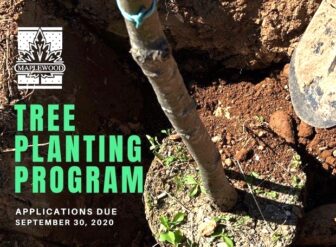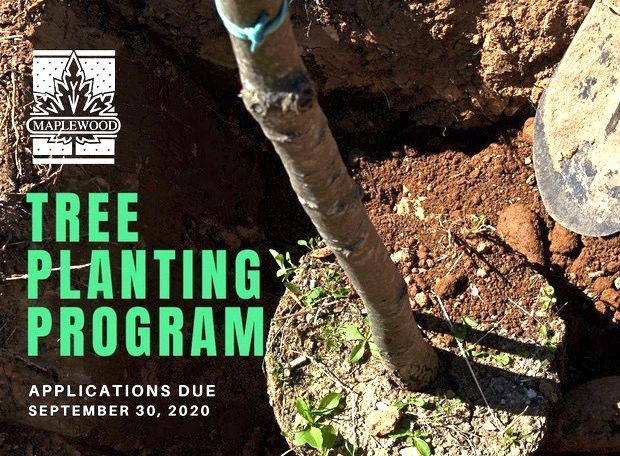Submit your request to the City of Maplewood by September 30 to receive your free trees planted between the sidewalk and the street this autumn. That is correct, the Maplewood Public Works Department, in conjunction with the Missouri Department of Conservation, will come to your house, determine which native tree will fit in your space without interfering with power lines, and not only give you a native tree for free but plant it for you.
Just complete the request form at http://mo-maplewood.civicplus.com/128/Tree-Planting-Program now.
 This perk for Maplewood residents is an easy opportunity for you to help improve the community on several levels. For you, trees will beautify your yard, reduce your summer cooling expenses, and increase your property value. For the city, trees absorb excess stormwater, reducing money spent on flooding and sewer maintenance. For your neighbors, trees clean the air, provide oxygen, and improve mental health. For the environment, native trees provide nutrient cycling, food and habitat for wildlife, carbon sequestration, and a functioning ecosystem.
This perk for Maplewood residents is an easy opportunity for you to help improve the community on several levels. For you, trees will beautify your yard, reduce your summer cooling expenses, and increase your property value. For the city, trees absorb excess stormwater, reducing money spent on flooding and sewer maintenance. For your neighbors, trees clean the air, provide oxygen, and improve mental health. For the environment, native trees provide nutrient cycling, food and habitat for wildlife, carbon sequestration, and a functioning ecosystem.
Let’s start with the benefits trees provide to you, the person who will submit the request at the link above. First off, trees are beautiful and make us feel more at home. Close your eyes and picture yourself walking down a tree-lined street with branches gracefully arching overhead. Now imagine yourself in the center of a football field. Which scenario makes you feel cozy? Which makes you feel exposed?
Second, trees will save you money. Deciduous trees, those that drop their leaves in the fall, absorb the sunlight that would otherwise contribute unwanted heat to your house in the summer. They drop their leaves at a very convenient time in the fall to allow sunlight to pass through their beautiful branches and warm your home in the winter.
Third, trees increase your property value. Maplewood was awarded a T.R.I.M. grant to survey trees on city-controlled property, including tree lawns, earlier this year. You can see the breakdown of eco-benefits each of the 2,500 individual trees provide on an interactive map at https://maplewoodmo.treekeepersoftware.com/.
In your case, you do not even have to think in terms of a return on investment (ROI), because these trees are free. The only investment is the time it takes to fill out the form at the link above.
Next we can consider the benefits that letting the city plant a free tree for you provides to the city. As you have probably noticed, the St. Louis area floods pretty easily. I read a study that listed us as one of the top three “flashiest” metropolitan watersheds in the contiguous United States, meaning that we see flash floods more frequently than most other cities.
This is due to a combination of factors including our location at the confluence of several rivers; our straddling two ecoregions, eastern temperate forest and tallgrass prairie, that are prone to heavy rain or periods of heavy rainfall, respectively; our replacement of the plants that would have historically absorbed all this rainfall with urban infrastructure and turfgrass that repel water; and our aging sewer systems.
Native trees form huge root systems (you can estimate that their roots underground match the mass of trees that you can see above ground) that act like sponges to soak up all that excess stormwater runoff from your impervious roof, driveway, and turfgrass lawn. Would you like to see your tax money either reduced or spent on something more interesting than flooding issues and sewer maintenance? Request a free tree above.
Now let’s consider the community. This past year has been challenging. Dealing with the changes caused by a pandemic, even without actually contracting the virus, adds a layer of background trauma to our already hectic lives.
Studies have shown that spending 30 minutes outside in natural settings reduced participants’ stress and blood pressure. These effects were amplified when the setting exhibited high degrees of structural biodiversity, meaning that, in addition to green grass, there were plants of various heights, including flowers, shrubs, understory trees such as redbuds and dogwoods, and tall trees. Trees also, through photosynthesis, produce oxygen. Would you like your neighbors to be calm, peaceful, and able to breathe? Request a free tree above.
Finally, trees are vital for the environment. Their roots and the underground ecosystems they foster actually help replenish nutrients in the soil through nutrient cycling. Native trees such as oaks provide habitat and food for up to 700 species of animals, whereas invasive non-native species such as Callery pears feed none. Through photosynthesis, trees inhale vast amounts of carbon dioxide and sequester it in their giant bodies, reducing the amount of harmful greenhouse gases in our atmosphere. Those same tree canopies that reduce your A/C use also cool the area around themselves through transpiration and creating shade. A quick, easy, and free step you can take to help the environment is to request a free tree at the link above.
Hopefully I have impressed upon you the importance of trees and the incredible opportunity you have to get one planted at your house for free. Yes, trees do drop leaves and sometimes branches, but Maplewood Public Works provides free leaf removal several times a year if you do not want to keep your leaves in place for the benefit of the butterflies and other pollinators who have laid eggs on them. The city will also remove your large limbs that fall after major weather events.
Yes, we have been certified by Tree City USA, but I see empty tree lawns when I walk my dog through our otherwise tree-lined streets, so we definitely have room for more. Please do yourself, the city, your community, and the environment a favor and request your free trees at http://mo-maplewood.civicplus.com/128/Tree-Planting-Program.
For additional ways to help, check out:
- Native Plant Sale at Schlafly Bottleworks this Saturday, October 3, from 9am to 2pm: https://stlouisaudubon.org/wp-content/uploads/2020/08/Native-Plan-Expo-Flyer-2020.pdf
- St. Louis Audubon’s Bring Conservation Home Program – Maplewood residents get reduced pricing on landscape assessments: https://www.stlouisaudubon.org/BCH
- Maplewood Sustainability Commission: http://mo-maplewood.civicplus.com/364/Sustainability
- Earn a master’s degree in conservation science through the Missouri Botanical Garden: https://discover.missouribotanicalgarden.org/aip
Jonathan Spencer is a Master Naturalist, graduate biology student through the Missouri Botanical Garden, and the chair of the Maplewood Sustainability Commission.


I hope everyone requests a free tree! So many reasons to plant trees. Thanks.
Nice work Jonathan. It’s a great program that I used to plant 2 white flowering Red Bud trees in my tree lawn.
Great, well written, informative article.
This is awesome! Thanks for letting us know.